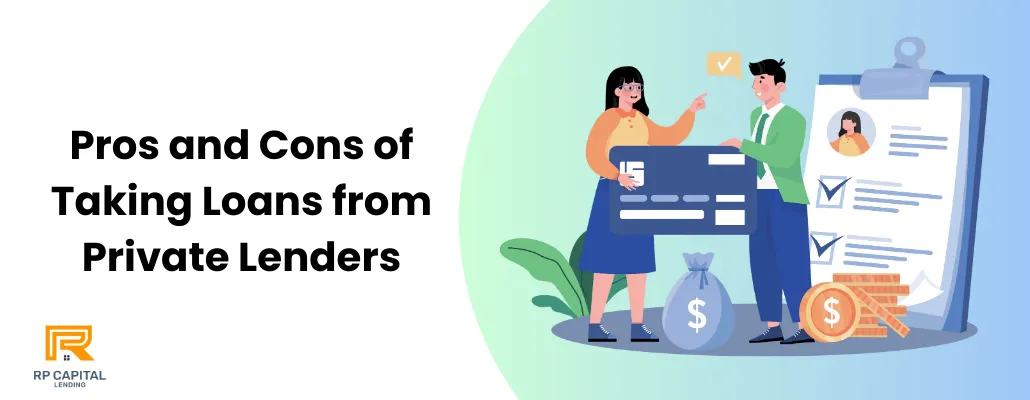Blog

Is a Loan from Private Lenders Worth It? Explore the Hidden Pros and Cons!
Pros and Cons of Taking Loans from Private Lenders: Key Insights & Real-Life Examples
When traditional bank loans aren't feasible, many individuals and businesses turn to loans from private lenders. These loans can be a viable option, but they come with distinct advantages and disadvantages that potential borrowers should understand.
This guide explores the key pros and cons of private lending, supplemented by real-life examples, facts, and statistics to help you make an informed choice.
What Are Private Lender Loans?

Private lender loans are financing options provided by non-bank entities, such as individuals, private institutions, or peer-to-peer lending platforms. They differ from traditional bank loans in flexibility, eligibility requirements, interest rates, and terms. These loans cater to borrowers who may not qualify for conventional loans due to credit issues, non-standard income sources, or urgent funding needs.
Pros of Taking Loans from Private Lenders

1. Flexible Terms and Conditions
Private lenders often offer flexible loan terms compared to traditional banks. Since private lenders have more autonomy, they can tailor terms to the borrower’s situation, providing options like interest-only loans or adjustable terms.
Example:
Imagine an entrepreneur with inconsistent income who needs a loan for a startup. A private lender might agree to a loan with interest-only payments for the first year, reducing the financial strain in the company’s early stages.
2. Quick Approval Process
Private loans typically have a faster approval and funding process than bank loans. Private lenders can approve and disburse loans within days, while traditional banks may take weeks due to strict procedures and background checks.
Example:
For someone looking to seize a real estate investment opportunity quickly, a private lender can provide funds much faster than a bank, allowing them to close the deal on time.
3. Access for Low Credit Borrowers
Many private lenders are willing to overlook a low credit score if the borrower has other strengths, such as collateral or consistent income. This leniency allows people with credit challenges to access funds they might otherwise be denied by traditional lenders.
Example:
If a small business owner has a credit score under 600 due to previous financial difficulties, a bank might deny them a loan, while a private lender may approve it based on the value of their assets.
4. Higher Approval Rates
Since private lenders aren’t bound by the same regulations as traditional banks, they can approve loans that might not meet standard criteria. This results in higher approval rates, especially for self-employed individuals, freelancers, or entrepreneurs with unconventional income.
Fact:
According to a study by Harvard Business School, nearly 65% of private lender loan applicants get approval, compared to just 45% for traditional bank loans.
Cons of Taking Loans from Private Lenders

1. Higher Interest Rates
The flexibility of private lenders comes at a cost. Private lender loans often carry higher interest rates, reflecting the higher risk these lenders take. Borrowers can expect rates anywhere from 8% to 15% or even higher, depending on the lender and loan type.
Example:
If a borrower takes out a $50,000 loan with a private lender at 12% interest, they would pay $6,000 in interest over a year. A similar loan from a traditional bank at 5% would only cost $2,500.
2. Less Consumer Protection
Private loans don’t always come with the same legal protections as bank loans. If the borrower faces difficulties, there may be fewer resources to help them, and some private lenders might engage in aggressive repayment collection practices.
Note:
It’s essential to check the reputation of private lenders, read reviews, and seek professional advice before committing to a private loan.
3. Shorter Repayment Periods
Private lender loans often come with shorter repayment terms, which can mean higher monthly payments. This can be challenging for individuals or businesses without a steady cash flow to manage.
Example:
Imagine a borrower who takes a $100,000 loan with a one-year repayment term. They’d need to pay around $8,333 monthly (plus interest), a considerable amount compared to longer-term bank loans.
4. Collateral Requirements
Some private loans are secured, meaning the borrower must put up collateral. If they default, the lender has the right to seize the asset, whether it’s a home, car, or other valuable property.
Example:
A private lender might require a real estate investor to use their new property as collateral. If the investor fails to make payments, the lender could claim ownership of the property.
Visualizing the Pros and Cons: A Quick Comparison
Below is a comparison table summarizing the key advantages and disadvantages of private lender loans.

When to Consider Private Lender Loans?
Private lender loans might be beneficial if you:
Need funds quickly for an investment or emergency.
Have a non-traditional income that doesn’t meet bank criteria.
Can manage the higher interest rates and shorter repayment terms.
Have a low credit score but valuable assets to use as collateral.
Conclusion: Are Private Lender Loans Right for You?
Loans from private lenders can provide a valuable financial lifeline, especially in time-sensitive situations. However, the flexibility and accessibility come at the cost of higher interest rates and potentially less consumer protection. Weighing these pros and cons and understanding the implications is essential for making an informed decision.
FAQs
1. What are private lender loans?
Private lender loans are financing options offered by individuals or private institutions, rather than traditional banks, often with flexible terms and faster approvals.
2. What are the main advantages of loans from private lenders?
\They offer flexible terms, quick approvals, accessibility for low-credit borrowers, and generally have higher approval rates than traditional bank loans.
3. Are there any downsides to taking loans from private lenders?
Yes, private lender loans often have higher interest rates, shorter repayment periods, collateral requirements, and fewer consumer protections.
4. When should I consider a private lender loan?
Consider a private lender if you need fast funding, have non-traditional income, or low credit but can handle higher interest and shorter terms.
5. Do private lenders require collateral?
Many private lenders require collateral, such as property or other assets, especially for larger loans or when credit history is weak.
Read More:
How to Calculate Square Feet of a House: A Complete Guide
RP Capital Lending is a d.b.a of RP Capital Partners Inc (NMLS # 2469193) | Privacy Policy
Copyright © 2022. All Rights Reserved.
Disclaimer: Loans only apply to non-owner occupied properties. Rates, terms and conditions offered only to qualified borrowers, may vary upon loan product, deal structure, other applicable considerations, and are subject to change at any time without notice.

